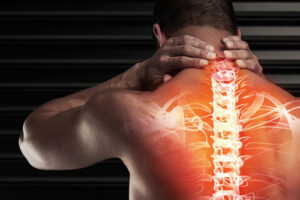Posterior Lumbar Fusion (PLF)
Posterior Lumbar Fusion (PLF) surgery is a surgical procedure in which the back part of the lumbar spine is fused from the back. This procedure is called a “posterior” lumbar fusion because the surgery is performed from the back (or “posterior” aspect) of the body as opposed to surgeries performed from the front or side of the body.
The surgeon makes an incision in the lower back, through the muscles. It is common to perform decompression surgery combined with the PLF. A bone graft is placed along the edges of the back part of the spine. Often, pedicle screws are placed into the vertebral bodies and connected with rods. This helps to stabilize the spine.
Lumbar fusion surgery is performed for a variety of conditions. Broadly speaking, fusion surgery is required when there is spinal instability, a deformity, or occasionally when the stenosis is very severe. Examples of these conditions include spondylolisthesis (when one vertebra slips forward relative to the vertebrae below it), spinal deformity, scoliosis, kyphosis, flatback syndrome, stenosis, and in patients with previous spine surgery.
 Diagnostic Tools
Diagnostic Tools
- X-rays of the lumbar spine
- MRI of the lumbar spine
- CT scan of the lumbar spine
- Discogram
Non-Operative Treatments
- Physical therapy
- Pain medications/NSAIDs/Muscle relaxers
- Steroid injections and facet joint ablation procedures
Conditions Require 360° Fusion?
- Degenerative disc disease of the lumbar spine
- Instability or spondylolisthesis of the lumbar spine
- Fracture of the lumbar spine
- Tumor or Infection of the lumbar spine
- Post-discectomy syndrome
What to Expect
Once you have decided to have surgery:
- A medical examination and clearance for surgery from your primary care physician to ensure that you’re in the best possible condition to undergo the operation.
- Chest x-ray, electrocardiogram (EKG), and blood work.
- You may be asked to have a neurological or psychological examination.
- If you are taking aspirin or anti-inflammatory medications daily, stop these medications at least one week before the lumbar fusion surgery.
- If you take prescription medications or other drugs, including herbals and supplements, ask your doctor how soon you should stop taking these before the lumbar fusion surgery.
- Do not have anything to eat or drink after midnight the night before surgery.
- You will check into the hospital the morning of surgery.
- Prior to the lumbar fusion surgery, you will be asked to sign permits for surgery, anesthesia, blood, and blood products.
- This surgery starts with positioning the patient lying face-down on a special spine operating table after the patient has been put to sleep with general anesthesia. The skin is then cleaned with an antiseptic solution.
- With the use of fluoroscopy (live x-ray) to identify the correct levels, the surgeon then makes a skin incision in the lower back and lifts the muscles off the bone to expose the back part of the spine. This includes the spinous processes (the bony projections off the back of the vertebrae) and the lamina bone (the bony roof over the back surface of the spinal cord).
- It is common to perform a decompression procedure to relieve pressure off of the nerves in combination with the posterior lumbar fusion. Decompression involves removing bone spurs, disc herniations, thickened ligaments, and other structures that are pushing on the nerves.
- Once the surgeon has created more space for nerves, a bone graft is then placed against the bony elements of the spine in the spaces where the fusion is to take place.
- This bone graft can be taken from several sources including using your own bone that was removed during the decompression, bone harvested from your pelvis/iliac crest, or sterilized donor bone from the bone bank. Often spinal instrumentation (i.e. metal screws and rods) is placed to hold the vertebrae in place while the fusion is healing. The less motion there is between two bones, the higher the chance that they will successfully heal and fuse together.
- Finally, the muscles and soft tissues are put back in place and the wound is closed. Sometimes a drainage tube may be placed in the wound prior to closure to help prevent a hematoma (a pocket of blood) from forming.
- After the surgery is complete, you will be transferred to the recovery room. Patients typically spend 1 to 2 hours here before heading to their hospital room:
- While you are in recovery, your surgeon will contact your family to let them know how the surgery went.
- After going to a hospital room, you will be able to control your own pain medication through the use of a PCA pump. This machine will administer intravenous (IV) pain medication when you push a button, but it is also designed to prevent patients from taking too much.
- The hospital staff will usually get you out of bed the same day as the surgery or the next morning.
- Sometimes a brace or corset is prescribed to help reduce bending and promote healing of the fusion.
- If a drainage tube was placed, it is usually removed in 1 or 2 days.
- The hospital stay after a posterior lumbar fusion is usually 2-3 days, but will obviously vary depending on the magnitude of surgery.
- During this admission, you will work with physical therapists 2 – 3 times a day to learn safe ways to move, dress, and do your daily activities without putting extra strain on your back. They will also teach you a set of exercises that you can do at home.
- When you are ready to be discharged, you will be given any needed prescriptions and discharge instructions. You will be able to ride in a car or plane upon leaving the hospital.
- Once home, it is important to avoid bending, lifting, and twisting until you are cleared by your surgeon.
- Once enough healing has occurred, typically a few weeks after surgery, your doctor will start you on outpatient physical therapy.
Recovery:
- Recovery from lumbar fusion surgery varies greatly among patients and is dependent on the extent of the surgery as well as the age and health of the individual.
- It is important to eat a healthy, balanced diet high in protein to aid in healing. It is similarly important to avoid smoking or using any nicotine products post-operatively because nicotine prevents your body from healing the fusion.
- In general, it takes the human body 3 – 6 months for the bones to grow together and heal the fusion.
- Return to work varies greatly among patients and is related to overall health and the type of work you do.
- It is important to remember that posterior lumbar fusion is a complex surgery and back pain is seldom completely eliminated – the objective with fusion surgery is to reduce pain.
Frequently Asked Questions
- Pain control is individualized for each patient based on their history, the nature of the surgery, and the reported pain level.
- Pain medications are meant to help reduce the pain, but are not supposed to completely eliminate pain. In general, patients are given a PCA (patient controlled analgesia) pump to use right after surgery. This allows you to push a button and receive “on demand” intravenous (IV) pain medication. Once you are able to take pills by mouth, you will typically be transitioned over pain pills as these provide longer periods of pain relief than IV pain medication.
- One side effect of pain medication is constipation. Therefore, it is important to remember to take over-the-counter stool softeners (e.g. Colace, Docusate) and laxatives (e.g. Dulcolax, Senokot, Milk of Magnesia). Do NOT use any NSAIDs, such as aspirin, Advil, Motrin, ibuprofen, Aleve, or naproxen, after your fusion surgery because this can increase your risk of bleeding and interfere with bone healing.
- You can typically take a shower 3-5 days after your surgery, but do not take a tub bath or submerge the incision under water until your surgeon says it’s ok.
- Prior to showering, remove the gauze bandage. Often times, there will either be a purple or clear glue over the incision (aka Dermabond) or white Steri-Strip stickers on top of the incision. Do not scrub, pick at, or remove the Dermabond or Steri-Strips. These will fall off on their own.
- When showering, it is ok to let water run over the incision. Afterwards, pat the incision dry and apply a new gauze dressing over the incision. Keep your dressing clean and dry. Change the dressing once a day, or more often if it becomes dirty. Wash your hands before and after changing the dressing. Do not apply creams, lotions, or ointments on or near your incision.
- Check for signs of infection, such as swelling, redness, warmth to the touch, or yellow or green discharge.
- You will have a post-operative follow-up appointment with your surgeon a few weeks after surgery to ensure that your wound is healing appropriately, your pain is controlled, and your preoperative symptoms are improving.
- However, there are times when you should contact your surgeon’s office sooner:
- If your temperature exceeds 101.5º or if the incision begins to separate or show signs of infection (such as swelling, redness, warmth to the touch, or yellow or green discharge), call your surgeon’s office immediately.
- Also if you develop new or worsening pain, numbness, weakness, or loss of bowel or bladder control, you should contact your surgeon right away.
- Recovery time will vary depending on the number of levels fused, the specific type of surgery you had, your health and physical condition prior to surgery, and a variety of other factors. However, in general, patients are in the hospital for a few days before going home or occasionally to a rehabilitation facility.
- For the first several weeks, the goal is to take it easy, but you should stay mobile and continue to walk daily.
- It is important to remember not to lift anything heavier than a gallon of milk, bend or twist through the back, or do any impact activity (e.g. jogging, running, horseback riding, cross-training, etc.) until cleared by your physician.
- You will start physical therapy once adequate healing has taken place in your back, usually after a month or so.
- It takes the human body anywhere from 3-6 months in order to fully heal the fusion. Therefore, follow all activity limitations for several months post-operatively until your surgeon tells you that the fusion has fully healed.


 Diagnostic Tools
Diagnostic Tools